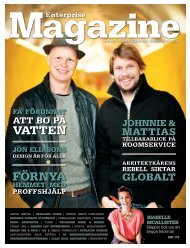Mexico’s Mining Industry
Mexico is a competitive destination for mining investment. An industry with a century-old tradition, mining remains one of the leading sources of income, employment and development in the country. But beyond the mineral wealth required to develop this activity, conditions in Mexico have made it one of the main destinations in the world for mining investment, surpassing countries that are richer in mineral resources.
Mexico is a competitive destination for mining investment. An industry with a century-old tradition, mining remains one of the leading sources of income, employment and development in the country. But beyond the mineral wealth required to develop this activity, conditions in Mexico have made it one of the main destinations in the world for mining investment, surpassing countries that are richer
in mineral resources.
You also want an ePaper? Increase the reach of your titles
YUMPU automatically turns print PDFs into web optimized ePapers that Google loves.
14 Negocios ProMéxico<br />
“i sTRonGly Believe ThaT This is<br />
mexiCo’s Time; The Time To seize<br />
oppoRTuniTies and advanTaGes and<br />
CapiTalize on Them as The GloBal<br />
eConomy GaTheRs momenTum.”<br />
the global economy, Mexico has maintained, even<br />
strengthened, its bet on free trade. In light of the recent<br />
financial turbulence, Mexico decided to move ahead with<br />
its economic liberalization program and not only avoided<br />
adopting protectionist measures, but furthered the<br />
elimination of tariffs and the liberalization of several goods<br />
and services.<br />
With the positive results achieved through the<br />
country’s economic openness strategy, the next step is to<br />
stay the course but with a new perspective.<br />
The strategy is to continue pushing <strong>Mexico’s</strong><br />
foreign trade, diversifying both the goods and services<br />
that the country exports and their destinations. To do<br />
so, Mexico is involved in a new generation of free trade<br />
agreements that seek to strengthen the multilateral<br />
trade system and favor regional economic integration<br />
to consolidate global supply chains.<br />
These agreements seek to create synergies and leverage<br />
the specific attributes of each participating economy, to<br />
integrate more solid trade and economic blocs that favor<br />
regional growth and economic development.<br />
—What do you mean when you talk about global<br />
supply chains?<br />
The concept of global value chains means that production<br />
is no longer carried out in one country. Every process,<br />
from producing raw materials to transforming them into<br />
finished goods, is done where the skills, materials, cost and<br />
quality conditions are.<br />
Therefore, a product can be designed in the US<br />
while its parts are manufactured in China and the final<br />
product assembled in Mexico, only to be exported back<br />
to the US, where it is sold to the end consumer.<br />
In this way, import-export statistics lose importance;<br />
what matters is being the country that adds more value to<br />
products, especially in terms of intensive use of knowledge<br />
and complex manufacturing processes.<br />
Mexico has a highly productive export sector that is<br />
internationally competitive, rapidly growing and makes<br />
intensive use of capital and technology.<br />
—In which global supply chains can Mexico become a<br />
key link?<br />
Our country is ready to support more innovation and<br />
high technology activities because we have the necessary<br />
human capital and experience, as well as an economy that<br />
exports sophisticated products.<br />
The goal is to support every sector in the country to<br />
help them move forward in their transition to advanced<br />
manufacturing, with special attention on boosting those<br />
industries that are able to generate more technology and<br />
knowledge transfer, such as the automotive, auto parts,<br />
aerospace, IT and software, electric-electronic, medical<br />
devices and renewable energies.<br />
Mexico is already a very attractive destination for these<br />
sectors. The goal is to seize this opportunity as a country<br />
and further the competitiveness of these industries.<br />
—What is <strong>Mexico’s</strong> position in the area of advanced<br />
manufacturing?<br />
Mexico is currently a leader in advanced manufacturing.<br />
It is the third largest exporter among G20 members<br />
in medium and high technology manufacturing, as a<br />
percentage of the GDP; Mexico is behind Germany and<br />
South Korea and ahead of China, France and even Japan,<br />
which are globally renowned for their technological<br />
capacity. In addition, we are the leading exporter of<br />
medium and high technology in Latin America.<br />
An interesting fact is that Mexico is home to more<br />
than 200 research and development centers that<br />
belong to global companies such as Dupont, Honeywell,<br />
General Electric, Intel, Ford, Mabe and Ericsson,<br />
among many others.<br />
For this reason, we are looking for a support policy<br />
that includes the manufacturing, services and research<br />
and development sectors. We are speaking of a modern<br />
industrial policy where all sectors make a coordinated<br />
effort to move forward. In that sense, supporting<br />
innovation and productivity in our country will be crucial<br />
tools to achieve this goal.<br />
—What is <strong>Mexico’s</strong> goal with this policy?<br />
I am very optimistic for <strong>Mexico’s</strong> future. Currently,<br />
the country is very well positioned and continues<br />
to improve its advanced manufacturing capacities,<br />
strengthening its internal market and consolidating<br />
domestic production chains.<br />
As I have said before, I strongly believe that this<br />
is <strong>Mexico’s</strong> time; the time to seize opportunities and<br />
advantages and capitalize on them as the global economy<br />
gathers momentum.<br />
Mexico is ready to face today’s challenges, and<br />
I agree with the various analyses that say that the<br />
country will become one of the strongest economies in<br />
the world in the coming years. That is the main goal of<br />
the policies we are implementing.<br />
—What is ProMéxico’s role in this scenario?<br />
At ProMéxico we are working and will continue to work<br />
very hard in the next few years to become the best ally of<br />
companies seeking to export from Mexico and companies<br />
that want to transfer their operations here.<br />
We want to strongly support every investment project<br />
that generates opportunities and well-paid jobs for<br />
Mexicans. We also want to be facilitators who help every<br />
project that comes into our country prosper.<br />
In that sense, we want to work with a higher<br />
degree of integration in every area: with the states,<br />
the business sector and the academic sector. We want<br />
to establish a link with the country’s manufacturing<br />
sector, working hand in hand to generate more<br />
opportunities for growth and development. n<br />
mexico:<br />
a Virtual<br />
Success Story<br />
____<br />
by guillermo rodríguez abitia*<br />
photos archive<br />
mexiCo is seT To BeCome a GReaT<br />
pRoduCeR of viRTual RealiTy<br />
appliCaTions. The evoluTion of<br />
The viRTual RealiTy indusTRy<br />
in mexiCo Will aid oTheRs ThaT<br />
aRe CuRRenTly BoominG in The<br />
CounTRy, like The auTomoTive,<br />
aeRospaCe, TouRism, healTh<br />
seRviCes, and eneRGy indusTRies,<br />
pRovidinG a feRTile GRound<br />
foR a sTRonG leveRaGinG of<br />
oppoRTuniTies and sTRenGThs.<br />
Negocios ProMéxico 15<br />
For most people, virtual reality<br />
has become a commonplace term<br />
in their everyday lives. Today,<br />
children have grown accustomed<br />
to interacting with computer games or<br />
watching movies and TV programs in 3D.<br />
Professionals rely on computer programs<br />
which allow them to design models of<br />
buildings, structures, pieces of machinery,<br />
furniture or even fashion garments, to get<br />
a better idea of how prototypes look from<br />
different perspectives.<br />
Even though virtual reality has been<br />
around for some decades, it is until now<br />
that its presence has become pervasive in<br />
people’s lives, at many levels.<br />
whaT is virTual realiTy?<br />
Some of the concepts used in information<br />
technology jargon, like artificial intelligence<br />
and virtual reality, have caused people<br />
to get lost in translation and to misunderstand<br />
what virtual reality truly is.<br />
Virtual reality refers to the creation of an<br />
artificial world in which a user may interact<br />
in many levels. It may be semi-immersive,<br />
as is the case of video games and<br />
simple animated videos, where the definition<br />
of objects and the sense of depth give<br />
a clear three-dimensional perspective, requiring<br />
no more sophisticated equipment<br />
than a simple screen; or immersive, where<br />
through the use of special glasses or other<br />
equipment, one gets the feeling that objects<br />
“jump out” of the screen, which is what<br />
is known as 3D. The most extreme cases<br />
of virtual reality are those called “caves,”<br />
where a person stands within a 360-degree<br />
virtual world and interacts with it,<br />
rather than being just a passive viewer.<br />
At the National Autonomous University

















